|
|
|
#1 |
|
Avalon Senior Member
Join Date: Sep 2008
Location: So. Cal. U.S.
Posts: 4,205
|
Images of the sun updated several times a day,
     The Sun now The Sun now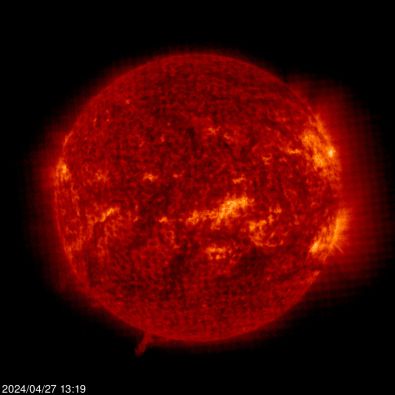 Image from the Extreme ultraviolet Imaging Telescope (EIT) These SOHO images are automatically updated throughout the day. If the images you see do not show today's date please refresh your page. CCD Bake-out If the image above shows 'CCD BAKEOUT', then this means EIT images are temporarily unavailable. In this case, there is nothing wrong with SOHO's EIT instrument. It is routinely taken offline every three months or so for a procedure known as 'bakeout' in order to maintain the performance of the instrument. The images will resume within 2-3 weeks. The Sun's hot atmosphere today See the bright twisted clouds of hot gas, revealing storminess, and the dark, calm regions called 'coronal holes'. These images, obtained with invisible ultraviolet light, give the scientists their routine weather maps of the Sun. Occasionally a solar flare appears, as a small, intensely bright flash. Different colours denote various ultraviolet wavelengths, each emanating from gas at a particular temperature - orange, 80 000 degrees, blue 1 000 000 degrees, green 1 500 000 degrees and yellow 2 500 000 degrees. http://www.esa.int/esaCP/ASE08Y9KOYC_Protecting_0.html Last edited by Dantheman62; 06-14-2009 at 08:57 PM. |
|
|

|
|
|
#2 |
|
Avalon Senior Member
Join Date: Sep 2008
Location: Washington state
Posts: 743
|
Fascinating, Dan, thanks!
alys |
|
|

|
|
|
#3 |
|
Avalon Senior Member
Join Date: Sep 2008
Location: So. Cal. U.S.
Posts: 4,205
|
There's alot more pictures at this link from ESA http://sohowww.nascom.nasa.gov/gallery/top10/
|
|
|

|
|
|
#4 |
|
Avalon Senior Member
Join Date: Sep 2008
Location: So. Cal. U.S.
Posts: 4,205
|
Here's another one with an Earth inset to show size of the CME
|
|
|

|
|
|
#5 |
|
Avalon Senior Member
Join Date: Sep 2008
Location: So. Cal. U.S.
Posts: 4,205
|
A sun spot 13 times larger than the surface of the Earth
|
|
|

|
|
|
#6 |
|
Avalon Senior Member
Join Date: Sep 2008
Location: U.K.
Posts: 3,380
|
I like this site-every day you get a different astronomical upload-there are archives also that go back years.Some interesting shots.
http://apod.nasa.gov/apod/archivepix.html Astronomical picture of the day website. |
|
|

|
|
|
#7 |
|
Avalon Senior Member
Join Date: Sep 2008
Location: So. Cal. U.S.
Posts: 4,205
|
Thanks A, very cool link with great pictures!, I'll remember that one.
|
|
|

|
|
|
#8 |
|
Avalon Senior Member
Join Date: Sep 2008
Location: U.K.
Posts: 3,380
|
I was quite impressed with the solar flare shot you posted above-i've seen many but not quite as striking as that.
|
|
|

|
|
|
#9 |
|
Avalon Senior Member
Join Date: Sep 2008
Location: So. Cal. U.S.
Posts: 4,205
|
go to the link in post #3 and there's some more pics!
|
|
|

|
|
|
#10 |
|
Avalon Senior Member
Join Date: Sep 2008
Location: So. Cal. U.S.
Posts: 4,205
|
Here's todays shot-12/30/08
|
|
|

|
|
|
#11 |
|
Avalon Senior Member
Join Date: Sep 2008
Location: So. Cal. U.S.
Posts: 4,205
|
Here's a cool picture of the 11 year solar cycle, each picture was taken by the SOHO Observatory and shows what the minimum and maximum solar activity years were. The next maximum solar activity year should fall around 2012, hmmm imagine that.
The Solar and Heliospheric Observatory (SOHO) celebrates its 12th launch anniversary on December 2. In late 1996, shortly after its launch, SOHO was able to observe the last minimum of the roughly 11-year activity cycle of the Sun. The minimum was followed by a rapid rise in solar activity, peaking 2001 and 2002. Activity levels have slowly declined since then, but we haven't reached solar minimum yet, despite passing 11.1 years since the last minimum — the average length of a solar cycle. In fact, the sunspot cycles measured since the mid-18th century vary in length from 9.0 to 13.5 years, and while a team of experts assembled by NOAA, NASA, and ISES has attempted to predict when the next solar minimum will be, we won't really know until we get there. The experts, in fact, were sharply divided about the time of the next minimum and the intensity of the next maximum, which should arrive about 2012 or 2013 |
|
|

|
|
|
#12 |
|
Avalon Senior Member
Join Date: Sep 2008
Location: So. Cal. U.S.
Posts: 4,205
|
This is a picture of one of the largest solar flares on record,
Solar flares are large explosions on the Sun's surface caused by a sudden release of magnetic energy. They are known to cause local short-lived oscillations traveling away from the explosion like water rings. This means that the flares drive global oscillations in the Sun in the same way that the entire Earth is set ringing for several weeks after a major earthquake such as the 2004 December Sumatra-Andaman one. |
|
|

|
|
|
#13 |
|
Avalon Senior Member
Join Date: Sep 2008
Location: So. Cal. U.S.
Posts: 4,205
|
SOHO TOP 30
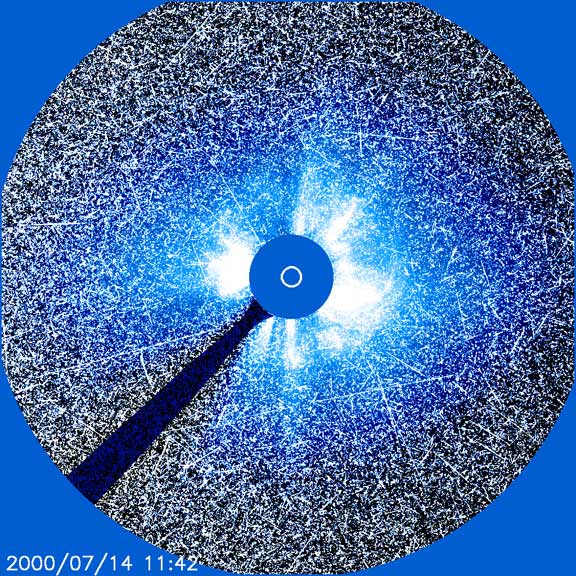 The "Bastille Day" particle storm and Earth-directed CME as seen by LASCO C3. More about this 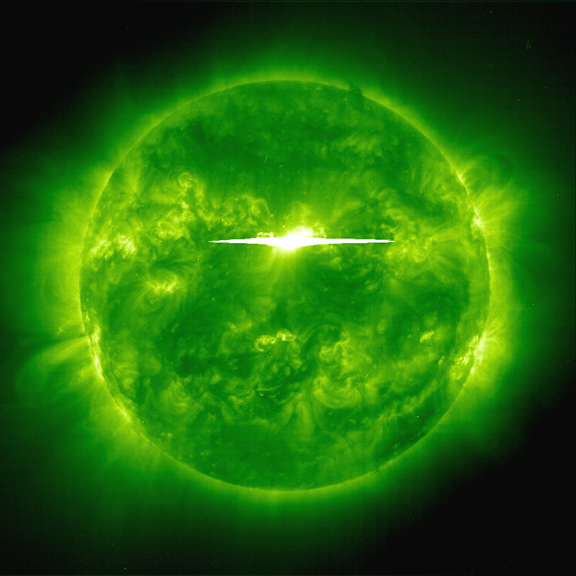 The "Bastille Day" flare as seen by EIT in the 195 Å emission line. More about this 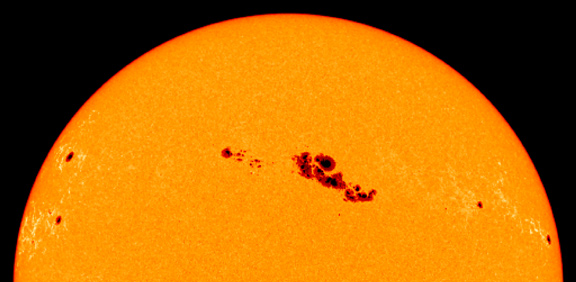 A sunspot thirteen times larger than the surface of the Earth. More about this  This EIT 171 Å image shows emission from ionised iron at about 1 million degrees C, revealing diffuse corona and magnetic loops. 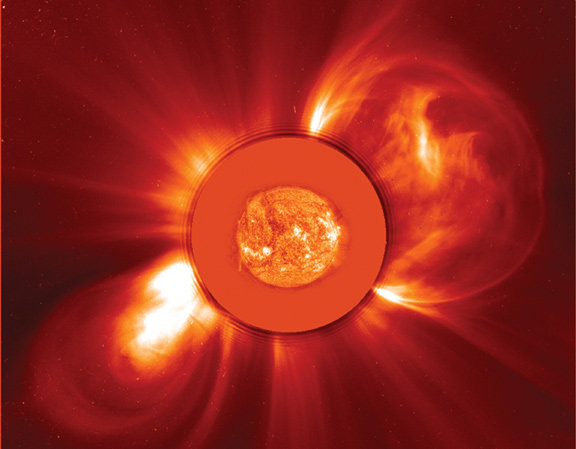 An impressive double set of CMEs observed by LASCO C2, with an EIT 304 Å inset in the middle. 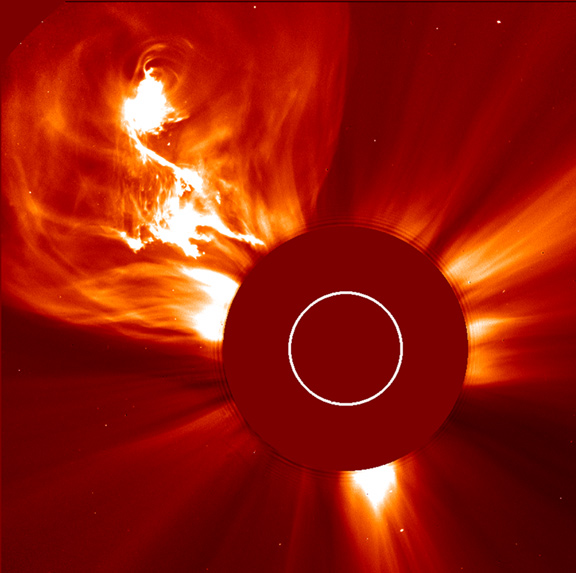 This fiery Coronal Mass Ejection (CME) shows stunning details in the ejected material. More about this 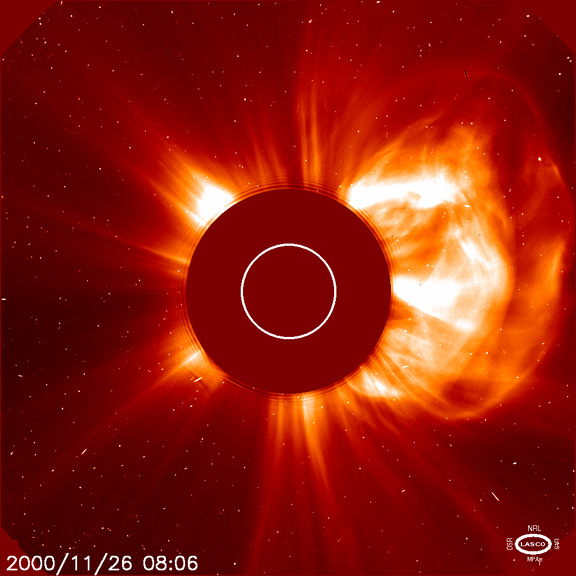 This spectacular Coronal Mass Ejection observed by LASCO C2 was interpreted as "Happy Birthday Fireworks" for the 5th anniversary of SOHO's launch. More about this 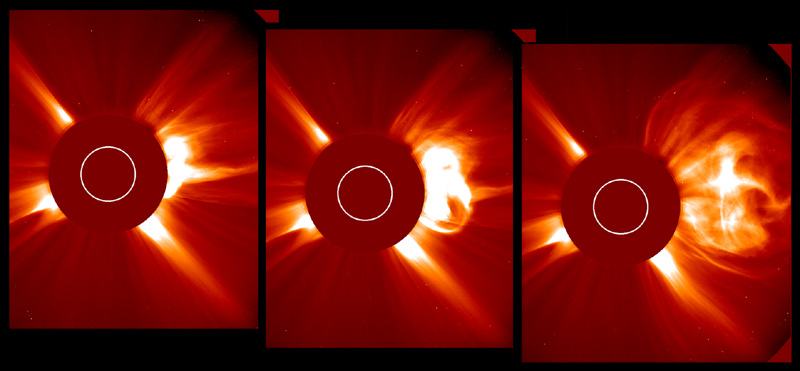 A sequence of LASCO C2 images showing the evolution of a Coronal Mass Ejection over a time span of about an hour 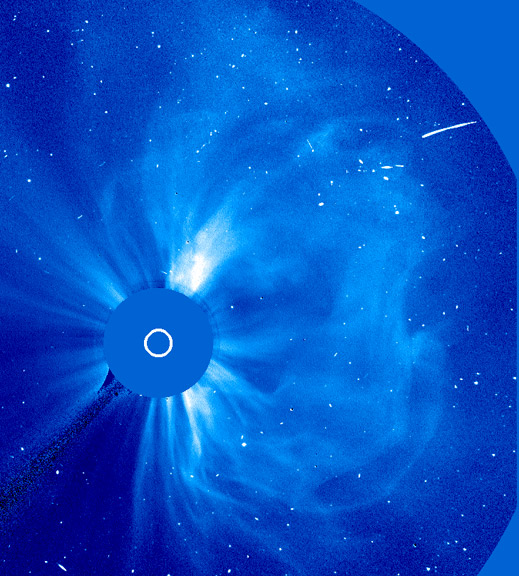 A Coronal Mass Ejection (CME) observed by LASCO C3 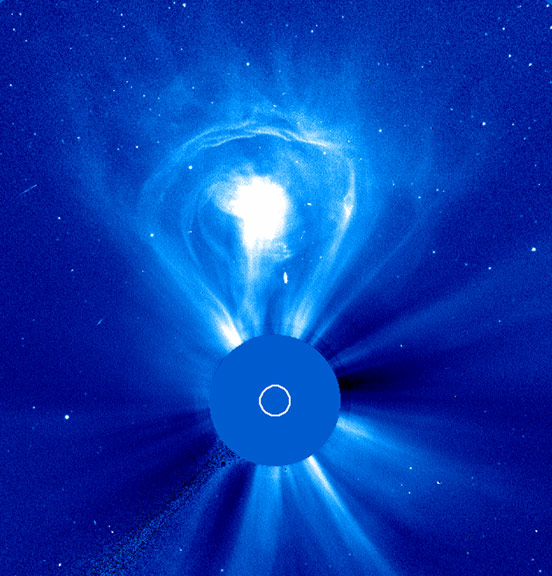 This "lightbulb" Coronal Mass Ejection (CME) shows the classical parts of a CME: leading edge, void, and core. More about this 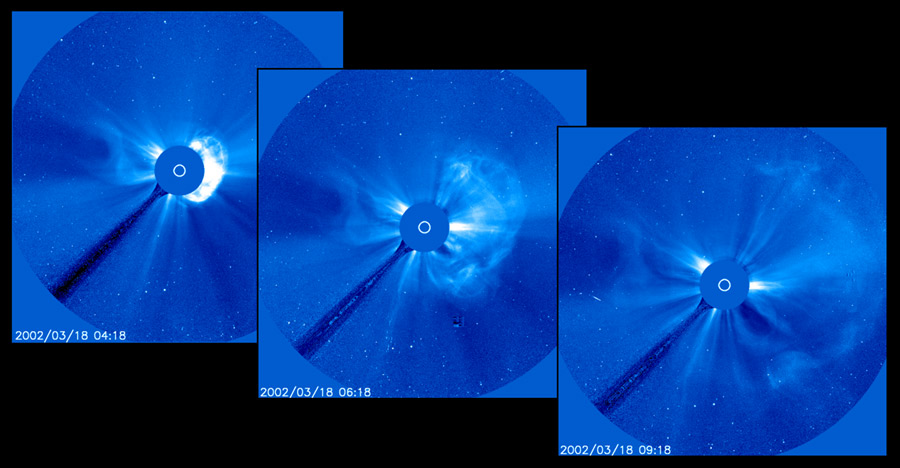 An Earth-directed Coronal Mass Ejection (CME) seen by LASCO C3. 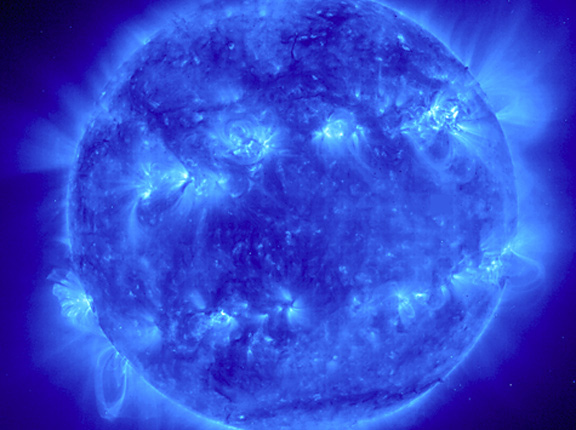 This EIT 171 Å image shows a wide variety of loops and active regions (lighter areas on the surface) 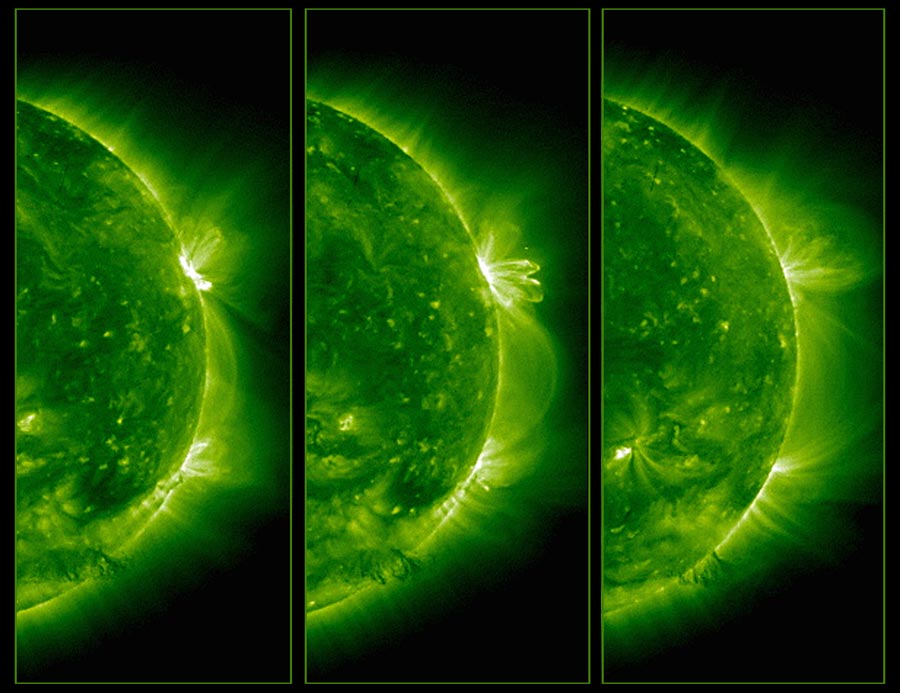 This EIT 195 Å series shows evolving loops stretched out above the edge of the Sun 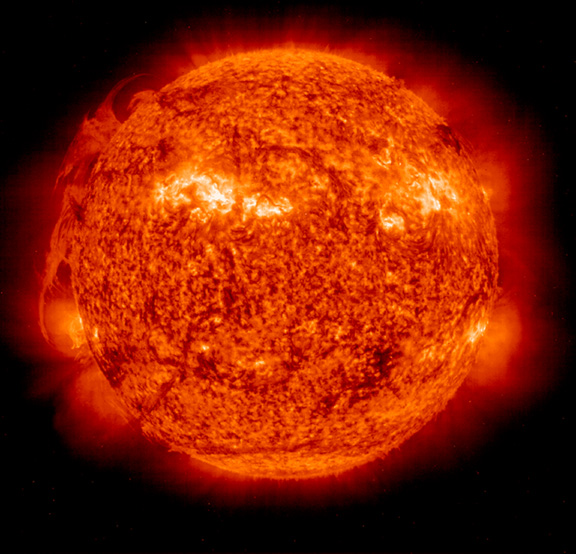 An EIT 304 Å image showing an unusual collection of prominences 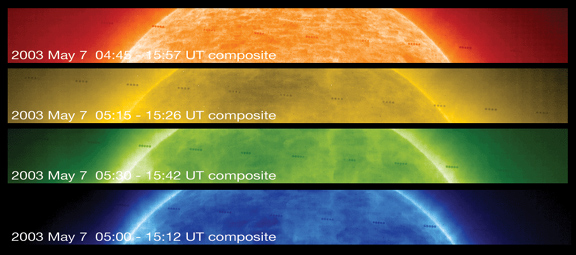 These EIT composite images show the passage of Mercury across EIT's field-of-view during the transit on 7 May 2003. More about this 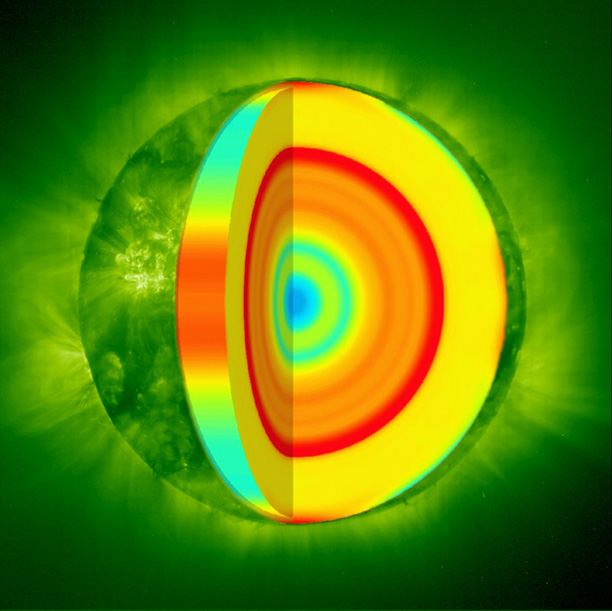 This combination of an EIT 195 Å image and a computed cutaway model of the Sun's interior shows "peculiarities" in the sound speed compared with theoretical models. More about this 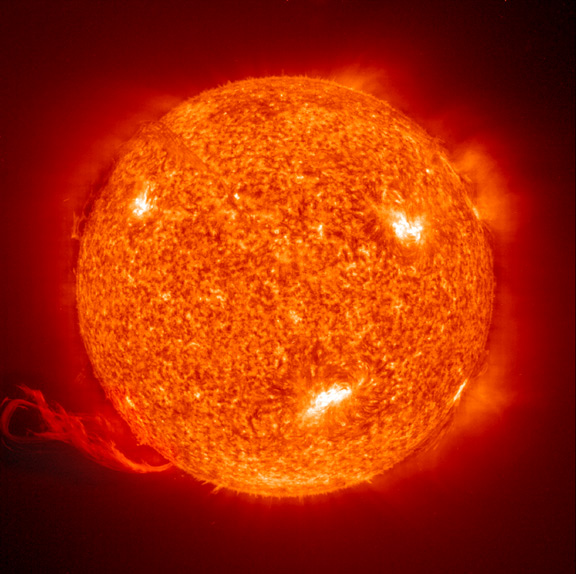 A particularly beautiful erupting prominence seen by EIT in 304 Å emission 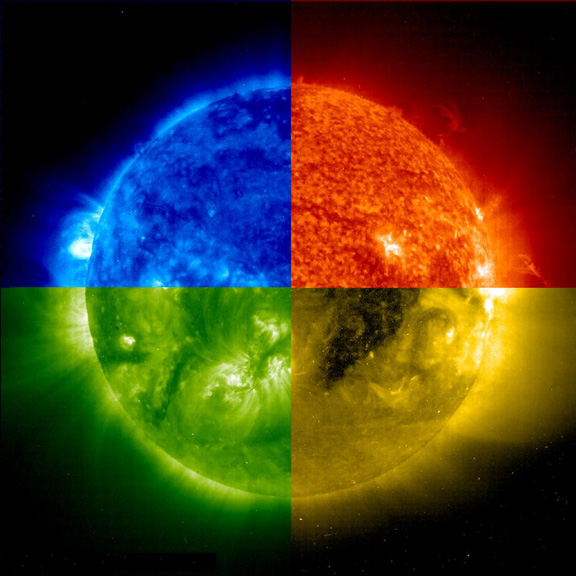 An "EIT colour wheel", showing images in the four filters of EIT. Clockwise from upper left: 171 Å, 304 Å, 284 Å, 195 Å. 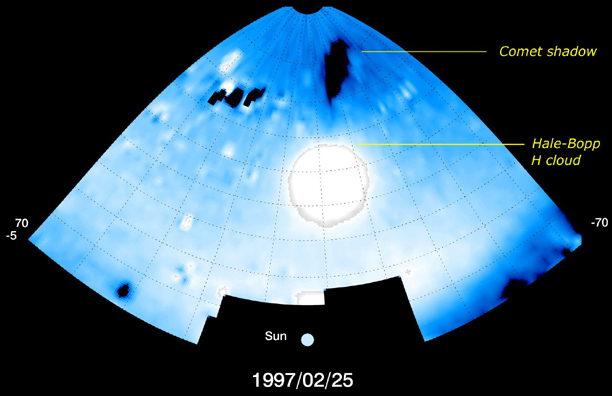 Comet Hale-Bopp and its shadow - cast on the diffuse material flowing into the solar system from the intergalactic wind. More about this 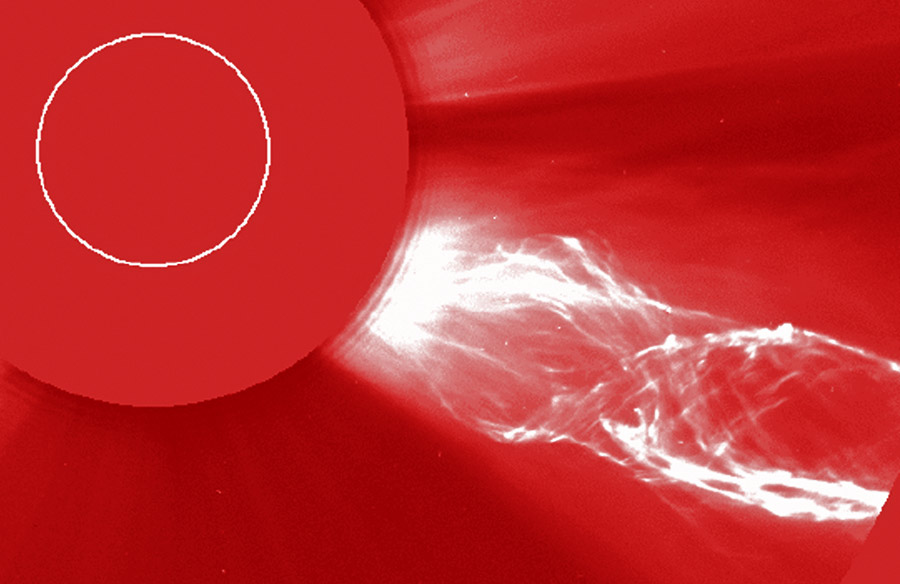 This unusual and clearly helical Coronal Mass Ejection (CME) was observed by LASCO C2 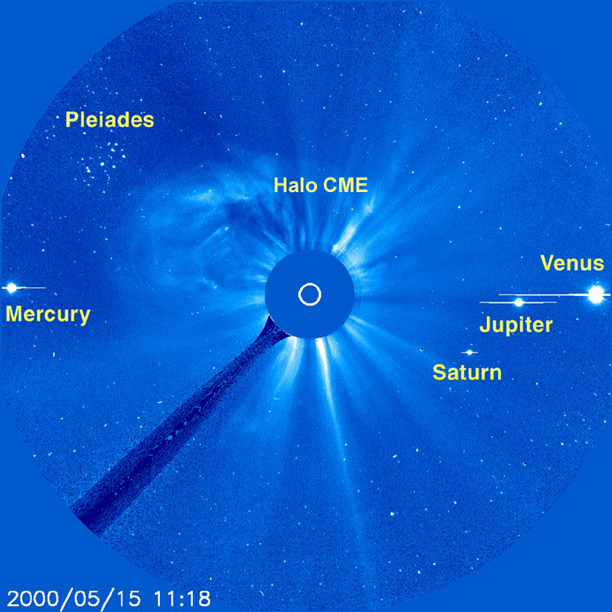 This image shows no less than four planets, the constellation Pleiades, and a halo Coronal Mass Ejection (CME). More about this 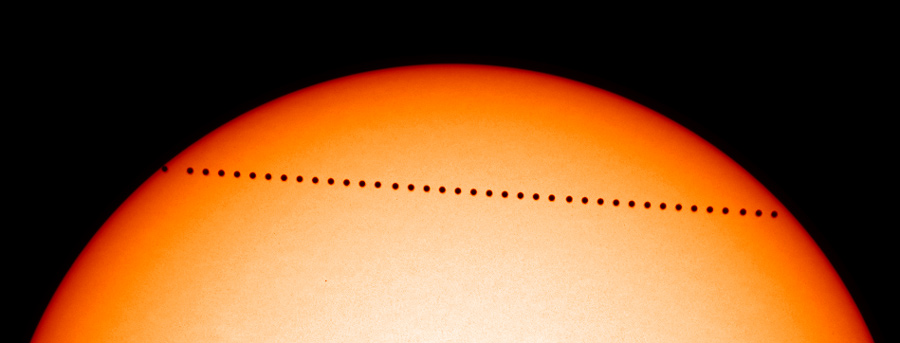 This MDI composite shows the passage of Mercury across the solar disk during the transit on 7 May 2003. More about this 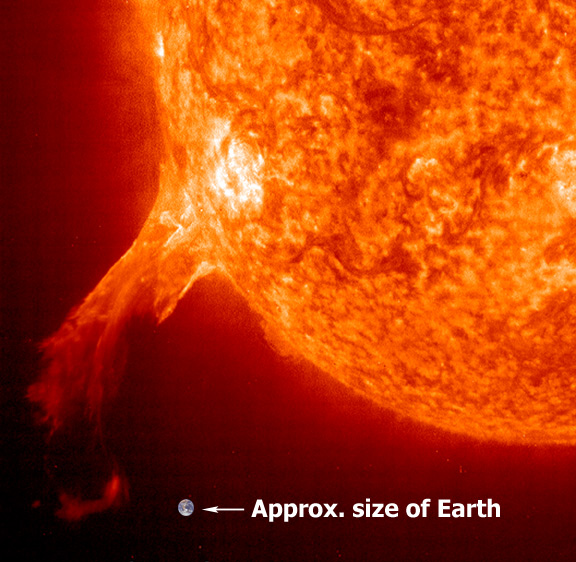 A closeup of an erupting Coronal Mass Ejection (CME) with Earth inset at the approximate scale of the image.  Our most breathtaking shots of a comet featured Comet NEAT (C/2002 V1) in the LASCO C3 field-of-view. More about this 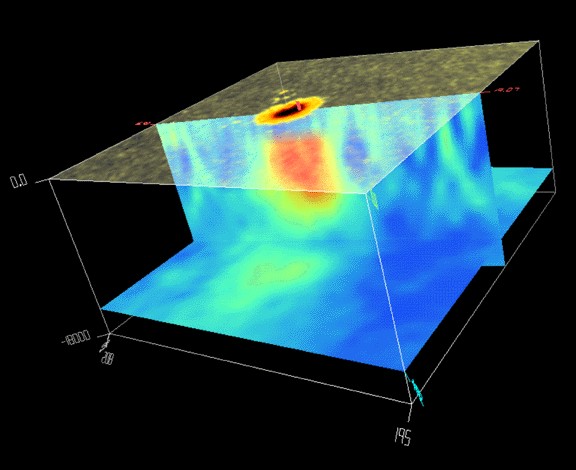 Using advanced analysis techniques, SOHO's MDI instrument can reveal the temperature and flow structure beneath sunspots. More about this,and yet more about this  This magnificent erupting prominence was captured by EIT in 304 Å emission. More about this 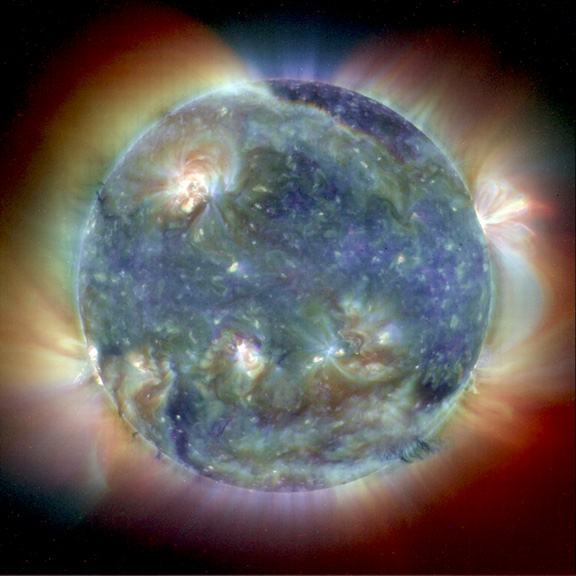 Composite image with three EIT wavelengths (171 Å, 195 Å and 284 Å) combined to show solar features unique to each wavelength. 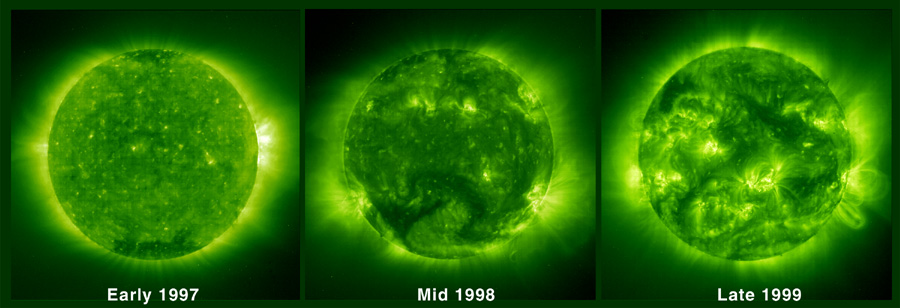 These three images show the incredible changes in the Sun's corona from near solar minimum to near solar maximum. 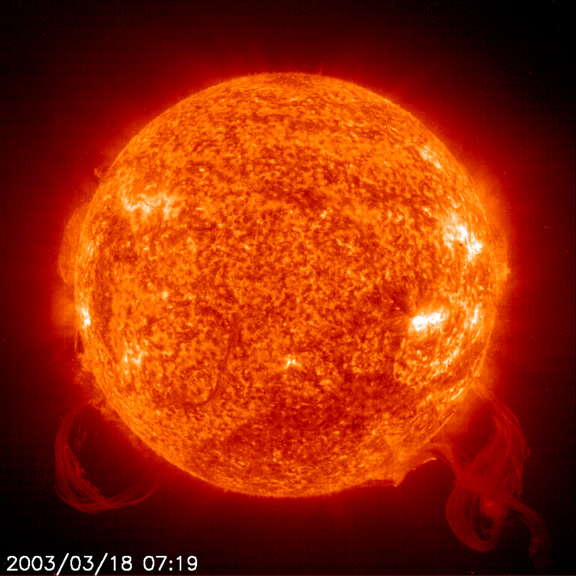 Two large eruptive prominences captured by EIT in 304 Å emission. More about this 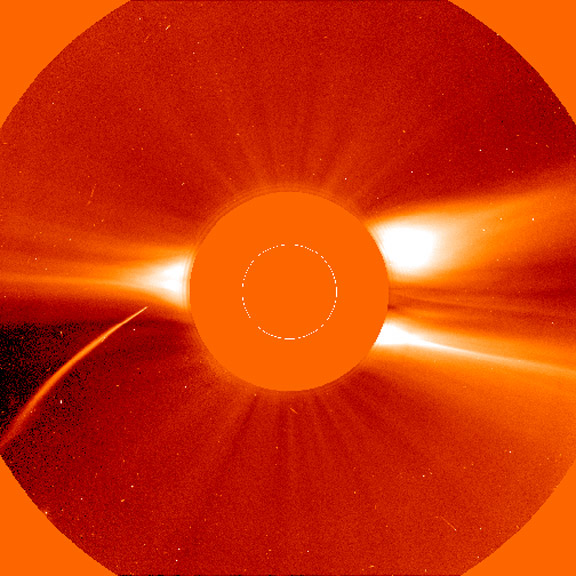 This LASCO C2 image from 23 December 1996 shows the "Christmas Comet" (Comet SOHO-6) streaking towards the Sun </SPAN> |
|
|

|
|
|
#14 |
|
Avalon Administrator
Join Date: Sep 2008
Location: North of 45° in Canada
Posts: 511
|
|
|
|

|
|
|
#15 |
|
Avalon Senior Member
Join Date: Sep 2008
Location: So. Cal. U.S.
Posts: 4,205
|
Spotless Sun: Blankest Year of the Space Age
10.06.08 Astronomers who count sunspots have announced that 2008 is now the "blankest year" of the Space Age. As of Sept. 27, 2008, the sun had been blank, i.e., had no visible sunspots, on 200 days of the year. To find a year with more blank suns, you have to go back to 1954, three years before the launch of Sputnik, when the sun was blank 241 times. "Sunspot counts are at a 50-year low," says solar physicist David Hathaway of the NASA Marshall Space Flight Center. "We're experiencing a deep minimum of the solar cycle." A spotless day looks like this (below left):  Left: A photo of the sun taken Sept. 27, 2008. The face of the sun is "blank," i.e., completely unmarked by spots. Left: A photo of the sun taken Sept. 27, 2008. The face of the sun is "blank," i.e., completely unmarked by spots.Right: The sun on Sept. 27, 2001. The sun's face is peppered with colossal sunspots, all crackling with solar flares. Credit: ESA/NASA Solar and Heliospheric Observatory (SOHO)  Top: A histogram showing the blankest years of the last half-century. The vertical axis is a count of spotless days in each year. The bar for 2008, which was updated on Sept. 27th, is still growing. Top: A histogram showing the blankest years of the last half-century. The vertical axis is a count of spotless days in each year. The bar for 2008, which was updated on Sept. 27th, is still growing.Bottom: A histogram showing the blankest years of the last century. As in the above histogram, the bar for 2008 is still growing. |
|
|

|
|
|
#16 |
|
Avalon Senior Member
Join Date: Sep 2008
Location: British Columbia, Canada
Posts: 372
|
Oh that wonderful Sun!! Lets hope that when 2012 comes it doesn't bake us with cosmic ray particles and cosmic dust! A nice gentle massage will do instead...
__________________________________________________ __ The End is the Beginning and the Beginning is the End...(Nothing New Under The Sun) |
|
|

|
|
|
#17 |
|
Avalon Senior Member
Join Date: Sep 2008
Location: Australia
Posts: 2,570
|
Nice Sun photos Dan

|
|
|

|
|
|
#18 |
|
Avalon Senior Member
Join Date: Sep 2008
Location: So. Cal. U.S.
Posts: 4,205
|
Coronal Holes:
 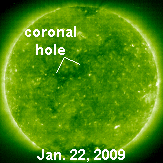  A solar wind stream flowing from the indicated coronal hole should reach Earth on or about Jan. 25th or 26th. Credit: SOHO Extreme UV Telescope A solar wind stream flowing from the indicated coronal hole should reach Earth on or about Jan. 25th or 26th. Credit: SOHO Extreme UV TelescopeGeomagnetic Storms: Probabilities for significant disturbances in Earth's magnetic field are given for three activity levels: active, minor storm, severe storm Updated at: 2009 Jan 22 2201 UTC Mid-latitudes 0-24 hr 24-48 hr ACTIVE 01 % 01 % MINOR 01 % 01 % SEVERE 01 % 01 % High latitudes 0-24 hr 24-48 hr ACTIVE 05 % 05 % MINOR 01 % 01 % SEVERE 01 % 01 % |
|
|

|
|
|
#19 |
|
Avalon Senior Member
Join Date: Sep 2008
Location: So. Cal. U.S.
Posts: 4,205
|
Solar Storms</B>
|
|
|

|
|
|
#20 |
|
Avalon Senior Member
Join Date: Sep 2008
Location: So. Cal. U.S.
Posts: 4,205
|
Aurora</B>
|
|
|

|
|
|
#21 |
|
Avalon Senior Member
Join Date: Sep 2008
Location: So. Cal. U.S.
Posts: 4,205
|

|
|
|

|
|
|
#22 |
|
Avalon Senior Member
Join Date: Sep 2008
Location: Scotland
Posts: 974
|
|
|
|

|
|
|
#23 |
|
Avalon Senior Member
Join Date: Sep 2008
Location: So. Cal. U.S.
Posts: 4,205
|
square UFO's LOL!, no not really, just a blotch in the camera image, every once in awhile you'll see a defect of some sort. Oh I see they're gone now, they must've corrected it! I guess they come and go.
Last edited by Dantheman62; 02-14-2009 at 09:50 PM. |
|
|

|
|
|
#24 |
|
Avalon Senior Member
Join Date: Sep 2008
Location: So. Cal. U.S.
Posts: 4,205
|
Forecast
The geomagnetic field is expected to be quiet to active on February 5 due to effects from CH358 and quiet on February 6-11. Active solar regions (Recent map)  Data for all numbered solar regions according to the Solar Region Summary provided by NOAA/SWPC. Comments are my own, as is the STAR spot count (spots observed at or inside a few hours before midnight) and data for regions not numbered by SWPC or where SWPC has observed no spots. SWPC active region numbers in the table below and in the active region map above are the historic SWPC/USAF numbers. A small recurrent coronal hole (CH358) in the southern hemisphere was in an Earth facing position on January 30-31.  Processed SOHO/EIT 195 image at 00:00 UTC on February 5. The darkest areas on the solar disk are likely coronal holes |
|
|

|
|
|
#25 |
|
Avalon Senior Member
Join Date: Sep 2008
Location: So. Cal. U.S.
Posts: 4,205
|
 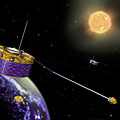 The Cluster constellation Cluster — the Sun-Earth connection in focus The Cluster constellation was launched in summer 2000 and started operating in early 2001. Since then, this four-satellite mission is performing the first and best ever stereo investigation of the Earth’s magnetosphere — the magnetic bubble surrounding our planet. Thanks to Cluster, scientists have reached an unprecedented understanding of the way solar activity affects the near-Earth environment. Cluster has provided the first 3D observation of magnetic reconnection in space — a phenomenon that reconfigures the magnetic field and releases high amounts of energy. Cluster pioneered measurements of electric currents in space, revealed the nature of black aurorae, and discovered that plasma — a gas of charged particles surrounding Earth — makes ‘waves’. The Cluster mission has been extended twice in the past, up to June 2009. The new extension will make it possible to study the auroral regions above Earth’s poles and widen the investigations of the magnetosphere — its inner region in particular. |
|
|

|
 |
«
Previous Thread
|
Next Thread
»
|
|
All times are GMT. The time now is 08:30 PM.




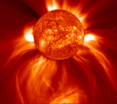
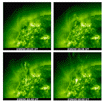

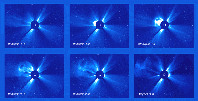
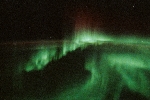
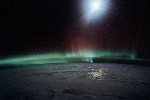
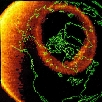
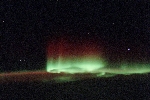
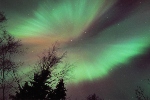
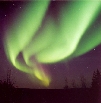
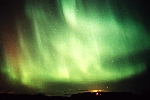


 Linear Mode
Linear Mode

